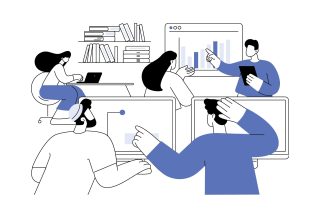FOCUS
Diversity in the teacher pipeline
Empower bilingual paraeducators to become teachers
By Toni Rader and Shawn Pennell
Categories: Career pathways, English learners, Learning designs, Reaching all studentsApril 2019
Vol. 40 No. 2
Read the remaining content with membership access. Join or log in below to continue.
Sed ut perspiciatis unde omnis iste natus error sit voluptatem accusantium doloremque laudantium, totam rem aperiam, eaque ipsa quae ab illo inventore veritatis et quasi architecto beatae vitae dicta sunt explicabo. Nemo enim ipsam voluptatem quia voluptas sit aspernatur aut odit aut fugit, sed quia consequuntur magni dolores eos qui ratione voluptatem sequi nesciunt. Neque porro quisquam est, qui dolorem ipsum quia dolor sit amet, consectetur, adipisci velit, sed quia non numquam eius modi tempora incidunt ut labore et dolore magnam aliquam quaerat voluptatem.
References
Bybee, R.W. (2015). The BSCS 5E instructional model: Creating teachable moments. Arlington, VA: NSTA Press.
Darling-Hammond, L., Hyler, M.E., & Gardner, M. (2017). Effective teacher professional development (Research Brief). Palo Alto, CA: Learning Policy Institute.
Deardorff, P., Glasenapp, G., Schalock, M., & Udell, T. (2007). TAPS: An innovative professional development program for paraeducators working in early childhood special education. Rural Special Education Quarterly, 26(3), 3-14.
Ellis, R. (2015). Understanding second language acquisition. Oxford, United Kingdom: Oxford University Press.
Giangreco, M.F. (2003). Working with paraprofessionals. Educational Leadership, 61(2), 50-53.
Gray, L., Taie, S., & O’Rear, I. (2015). Public school teacher attrition and mobility in the first five years: Results from the first through fifth waves of the 2007-08 beginning teacher longitudinal study. Washington, DC: National Center for Education Statistics.
Keller, C.L., Bucholz, J., & Brady, M.P. (2007). Yes, I can!: Empowering paraprofessionals to teach learning strategies. TEACHING Exceptional Children, 39(3), 18-23.
Krashen, S.D. & Terrell, T.D. (1983). The natural approach: Language acquisition in the classroom. London, England: Prentice Hall Europe.
Learning Forward. (2011). Standards for Professional Learning. Oxford, OH: Author.
National Center for Education Statistics. (2017). Fast facts: English language learners. Washington, DC: Author. Available at nces.ed.gov/fastfacts/display.asp?id=96.
Podolsky, A., Kini, T., Bishop, J., & Darling-Hammond, L. (2016). Solving the teacher shortage: How to attract and retain excellent educators. Palo Alto, CA: Learning Policy Institute.
Saunders, W., Goldenberg, C., & Marcelletti, D. (2013, Summer). English language development: Guidelines for instruction. American Educator, 37(2), 13-25, 38-39.
U.S. Department of Education. (2004). Title I paraprofessionals: Non-regulatory guidance. Washington, DC: Author.
Williams, C.P., Garcia, A., Connally, K., Cook, S., & Dancy, K. (2016). Multilingual paraprofessionals: An untapped resource for supporting American pluralism. Washington, DC: New America.
Categories: Career pathways, English learners, Learning designs, Reaching all students
Recent Issues
LEARNING DESIGNS
February 2025
How we learn influences what we learn. This issue shares essential...
BUILDING BRIDGES
December 2024
Students benefit when educators bridge the continuum of professional...
CURRICULUM-BASED PROFESSIONAL LEARNING
October 2024
High-quality curriculum requires skilled educators to put it into...
LEARNING TO PIVOT
August 2024
Sometimes new information and situations call for major change. This issue...












